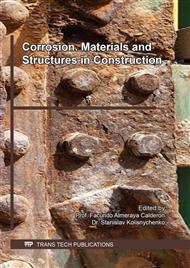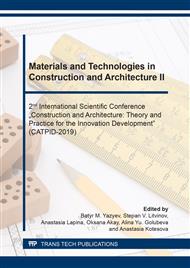[1]
V.I. Babushkin, Physical and Chemical Processes of Corrosion of Concrete and Reinforced Concrete, Stroyizdat Publ., Moscow, (1968).
Google Scholar
[2]
L.P. Zarubina, Waterproofing of Structures, Buildings and Constructions, BHV Publ., St.-Petersburg, (2011).
Google Scholar
[3]
A.A. Batayev, V.A. Batayev, Composite Materials, NSTU Publ., Novosibirsk, (2002).
Google Scholar
[4]
E.N. Kablov, O.V. Startsev, The basic and applied research in the field of corrosion and ageing of materials in natural environments (review), Aviation Materials and Techn. 4 (2015) 48-49.
DOI: 10.18577/2071-9140-2015-0-4-38-52
Google Scholar
[5]
A.A. Zaitsev, A.V. Maksimovskikh, S.V. Kaloshina, Secondary protection of concrete from corrosion, Modern Technologies in Construction. Theory and Practice. 1 (2016) 266-272.
Google Scholar
[6]
Yu.I Ladygin et al., Integrated approach in comparative research of chemical resistance of polymer composite material, Stroitel'nye materialy. 5 (2005) 52-53.
Google Scholar
[7]
R.A. Karamova, M.A. Tlekhusezh, Corrosion protection of concrete structures, European Student Scientific Journal. 3-7 (2018) 18729.
Google Scholar
[8]
N.Yu. Evstafyeva, T.K. Akchurin, I.V. Stefanenko, Polymer systems of waterproofing and corrosion protection of building materials and structures, Bulletin of Volgograd State University of Architecture and Civil Engineering. Series: Civil Eng. and Architecture. 53 (72) (2018) 43-52.
Google Scholar
[9]
O.V. Tarakanov, Concrete with Modifying Additives Based on Secondary Raw Materials, PSUACE Publ., Penza, (2004).
Google Scholar
[10]
V.S. Ramachandran, R.F. Feldman, M. Collepardi, Additives to Concrete. Teaching aid, Trasl. from Engl., Ed. by V.S. Ramachandran, Stroyizdat Publ., Moscow, (1988).
Google Scholar
[11]
RF National State Standard GOST 27677–88 (ST SEV 5852-86) Corrosion Protection in Construction. Concretes. General Requirements for Testing, Izdatelstvo Standartov Publ., Moscow, (1990).
Google Scholar
[12]
C. Qingyu, Polymer-modified concrete with improved flexural toughness and mechanism analysis, Journal оf Wuhan University оf Technology - Mater. Sci. Ed. 27 (3) (2012) 597-601.
DOI: 10.1007/s11595-012-0512-5
Google Scholar
[13]
I. Havlikova, Modified Cement-Based Mortars: Crack initiation and volume changes, Materiali in Tehnologije, 49 (4) (2015) 557-561.
DOI: 10.17222/mit.2014.179
Google Scholar
[14]
S. Marceau, Microstructure and mechanical properties of polymer-modified mortars, European Journal of Environmental and Civil Engineering, 16 (5) (2012) 571-581.
DOI: 10.1080/19648189.2012.675148
Google Scholar
[15]
T. Yaogang, S. Shuaifeng, J. Kan, H. Shuguang, Mechanical and dynamic properties of high strength concrete modified with lightweight aggregates presaturated polymer emulsion, Construction аnd Building Materials. 93 (2015) 1151-1156.
DOI: 10.1016/j.conbuildmat.2015.05.015
Google Scholar
[16]
RF National State Standard GOST Р 52804–2007 Protection against Corrosion of Concrete and Reinforced Concrete Constructions. Test Methods, Standartinform Publ., Moscow, (2008).
Google Scholar
[17]
Yu.V. Pukharenko, Corrosion-resistant nano-modified cement concretes, Concrete Technologies. 7-8 (2010) 24-28.
Google Scholar



